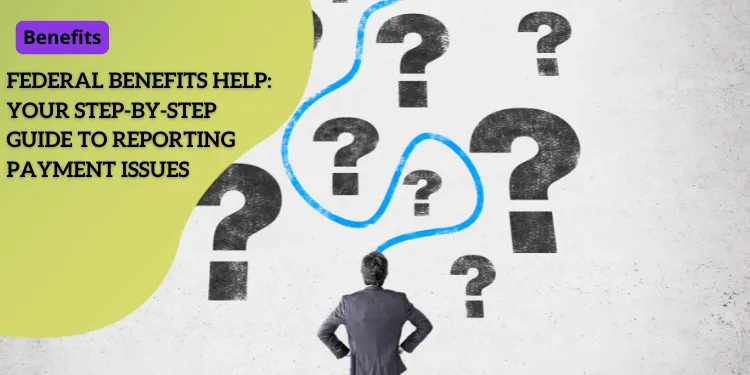Federal Benefits Help: Your Step-by-Step Guide to Reporting Payment Issues

Anúncios
Federal benefits can serve as lifelines for many individuals and families.
Unfortunately, payment issues can arise, causing unnecessary stress and financial hardship.
Anúncios
Understanding which benefits might face these problems and how to handle them can help ease the burden.
Different Types of Federal Benefits
Federal benefits come in many forms, such as Social Security, Supplemental Security Income (SSI), Supplemental Nutrition Assistance Program (SNAP), Temporary Assistance for Needy Families (TANF), and veterans’ benefits.
Anúncios
Each type of benefit serves different needs and populations, making the understanding of their unique payment processes crucial.
Common Payment Problems
Despite the structured payment processes, issues like late, missed, or incorrect payments can still occur.
Common scenarios include:
- Late Payments: Delays in the scheduled arrival of funds can disrupt budgeting plans.
- Missed Payments: Payments that fail to arrive altogether, causing significant financial strain.
- Incorrect Payments: Errors in the amount deposited, whether it’s more or less than what is due.
Importance of Promptly Reporting Payment Discrepancies
Addressing these issues as soon as they arise is vital.
Prompt reporting can prevent further financial complications and help rectify the problem quickly.
It ensures that the agency responsible for the benefit can investigate and correct any mistakes, ensuring that disruptions are minimal.
By identifying and understanding the types of federal benefit payment issues, recipients can be better prepared to act swiftly.
Proper and timely reporting not only aids in resolving the immediate issue but also contributes to the smooth administration of benefits in the future.
Social Security Payment Resolution
Contacting Social Security Administration
If you encounter issues with your Social Security payments—whether they’re late, missed, or incorrect—your first step should be to contact the Social Security Administration (SSA).
The SSA has a dedicated hotline for such concerns, which can be reached at 1-800-772-1213.
This toll-free number connects you with representatives who can help resolve payment issues and provide guidance on next steps.
TTY Services for Hearing Impaired
For individuals who are hearing impaired, the SSA offers TTY services.
You can access these services by calling 1-800-325-0778.
This ensures that all individuals have equal access to support, regardless of their hearing capabilities.
Online Resources
Another vital resource for addressing Social Security payment issues is the SSA’s official website.
Their website provides a wealth of information and tools to help you resolve payment discrepancies. You can:
- Check your payment status online
- Report any issues via their secure online messaging systems
- Find answers to frequently asked questions
Utilizing these online resources can often be a quicker way to find resolutions to your payment problems.
Next, we will look into assistance for SNAP benefits to ensure you have the necessary tools to address any issues that arise with your food stamp payments.
SNAP Benefits Assistance
Process for Reporting SNAP (Food Stamps) Payment Issues
If you encounter issues with your SNAP (food stamp) benefits, it’s crucial to report the problem promptly.
An effective way to begin the process is by contacting your local SNAP office.
Each state manages its own SNAP program, meaning local offices are best equipped to address and rectify issues specific to your situation.
To report a payment problem, such as a late, missed, or incorrect disbursement, you can:
- Call the SNAP hotline at 1-800-221-5689 for guidance.
- Visit your local SNAP office in person.
- Use the secure online messaging system available on the official SNAP website to report issues and check your payment status.
Importance of Contacting Local SNAP Office
Consulting your local SNAP office is essential because these offices have direct access to your case file.
They can provide specific assistance and ensure that your issues are addressed quickly.
Delays in reporting can lead to prolonged financial hardship, which is why addressing discrepancies as soon as they arise is so vital.
Required Documentation for Payment Resolution
When reporting an issue, having the necessary documentation can expedite the resolution process.
Typically, you will need:
- Your SNAP case number.
- Identification, such as a driver’s license or state ID.
- Recent correspondence from the SNAP office, if available.
- Specific details regarding the payment issue, like the date and amount of the missed or incorrect payment.
Being prepared with this information helps facilitate a smoother and quicker resolution of your SNAP benefit issues.
Knowing how to handle these issues and where to seek help can make a significant difference in maintaining your financial stability.
Next, let’s explore support systems for other federal benefits to ensure you’re well-equipped across all areas.
TANF Payment Support
Steps to Report Welfare Benefit Payment Errors
If you’re experiencing errors with your TANF (Temporary Assistance for Needy Families) payments, quick action is key.
Here’s a step-by-step guide on how to report these issues.
- Identify the Issue: Whether it’s a late, missed, or incorrect payment, make sure you have all the details. Date of the payment, the amount expected, and the discrepancy should be noted.
- Gather Documentation: Collect any relevant documents. This includes your case number, identification, and any correspondence regarding your benefits.
- Contact Your Local TANF Office: Reach out to your local TANF office, which can be found on the state’s human services website. You can report the issue via phone, in-person, or online.
Guidance on Contacting Local TANF Office
Your local TANF office is equipped to handle payment issues directly.
Here’s how you can get in touch:
- Phone: Call the office and provide your details and the nature of the problem. Have your case number and ID ready.
- Visit in Person: Sometimes a face-to-face meeting can expedite the resolution process. Bring all necessary documentation.
- Online Communication: Many states offer online portals where you can log payment issues and track the resolution progress.
Follow-Up Procedures for Payment Corrections
After reporting the issue, follow these steps to ensure your case is being handled appropriately:
- Receive Confirmation: Obtain a reference number for your complaint, whether you report it by phone, online, or in person.
- Set a Timeline: Ask the office how long the correction process will take. Timelines can vary based on the complexity of the issue.
- Regular Check-Ins: Regularly follow up with the office to get updates on your case status. This can prevent delays and show that you’re actively seeking resolution.
- Escalation: If the issue isn’t resolved within the promised time, consider escalating your complaint to a higher authority within the TANF office.
Ensuring you promptly report and follow up on payment issues can lead to a faster resolution and less financial strain.
This structured approach to resolving TANF payment issues will help clear up any concerns efficiently, allowing for smoother benefit distribution in the future.
Veterans Benefits Resolution
If you encounter challenges with veteran benefit payments, such as delays, missed disbursements, or incorrect amounts, taking prompt action is crucial.
The first step in resolving these issues is to contact the VA benefits hotline at 1-800-827-1000.
The hotline is staffed with representatives who can assist in identifying and correcting payment discrepancies.
Additionally, individuals with hearing impairments can access TTY services by dialing 711, ensuring that all veterans have access to the support they need.
Another essential resource for veterans is the ability to locate their local VA offices. By using your zip code on the VA.gov locator tool, you can find nearby offices that offer personalized support.
Local VA offices are well-equipped to handle a wide range of benefit-related issues, and in-person visits can sometimes expedite the resolution process.
Remember, promptly addressing any payment issues not only helps ensure that you receive the benefits you are entitled to but also contributes to the efficient administration of veteran services for everyone.
Take these steps to effectively manage and resolve your veterans benefit payment issues, and you’ll be on your way to ensuring your payments are accurate and timely.
Next Steps and Follow-Up
Documentation Needed for Payment Issue Resolution
When resolving payment issues with federal benefits, having the right documentation is crucial.
Each agency may require different forms of documentation to verify your claim. Here is a list of typical documents you may need:
- Personal identification (e.g., driver’s license, passport)
- Benefit award letter or notice
- Payment history or bank statements showing missed or incorrect payments
- Any correspondence you’ve had with the agency regarding the issue
Keeping organized records can help expedite the resolution process.
Timelines for Payment Corrections
The timeline for resolving payment discrepancies can vary.
Here’s a rough guide of what to expect:
- Social Security and SSI: Resolution can take anywhere from a few weeks to a few months, depending on the complexity of the issue.
- SNAP (Food Stamps): Payments are typically corrected within 30 days after reporting the issue.
- TANF (Welfare Benefits): Erroneous payments are often resolved within one to two months.
- Veterans Benefits: Payment corrections can take a few weeks to several months.
Be sure to follow up regularly to ensure your issue is being resolved.
Follow-Up Procedures with Respective Agencies
After reporting your issue, it’s important to follow through until your payment is corrected.
Here’s how to stay on top of it:
- Confirm Receipt: Make sure the agency acknowledges receiving your report and documentation.
- Track Progress: Keep a record of whom you spoke with and any reference numbers provided.
- Regular Check-Ins: Call the agency periodically to ask about the status of your case.
- Escalation if Necessary: If your issue isn’t resolved within the expected timeline, escalate the matter by asking to speak with a supervisor.
By documenting everything and keeping in regular contact, you increase the chances of a swift resolution to your payment issues.






